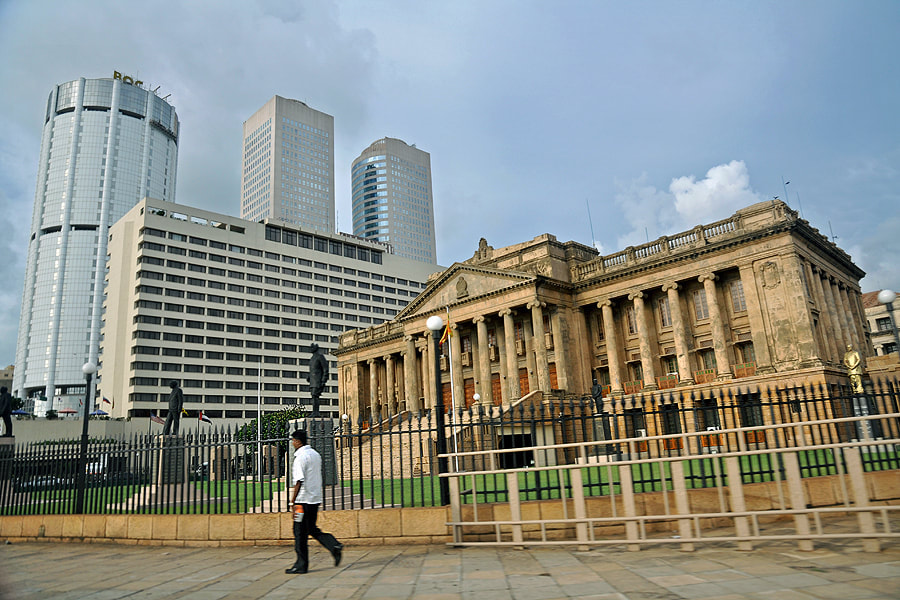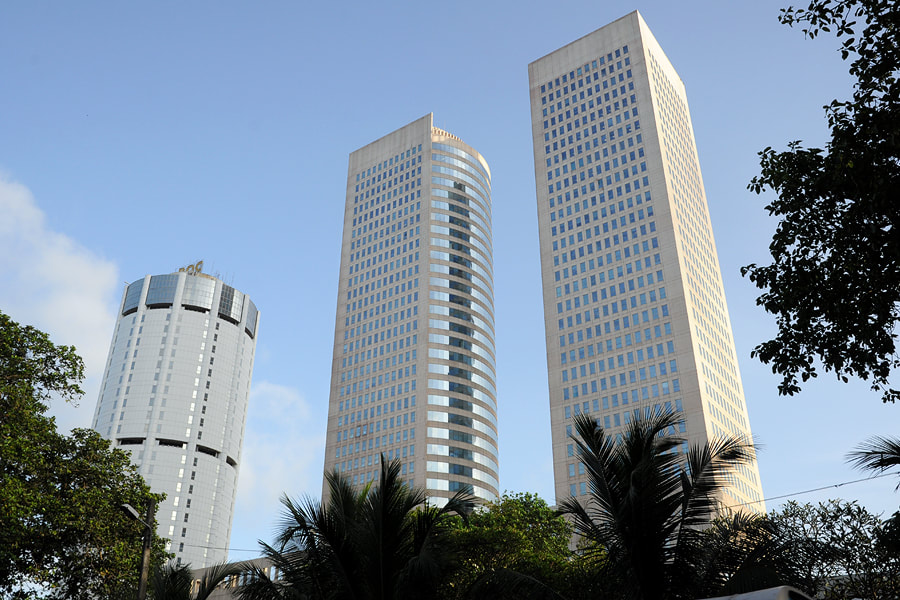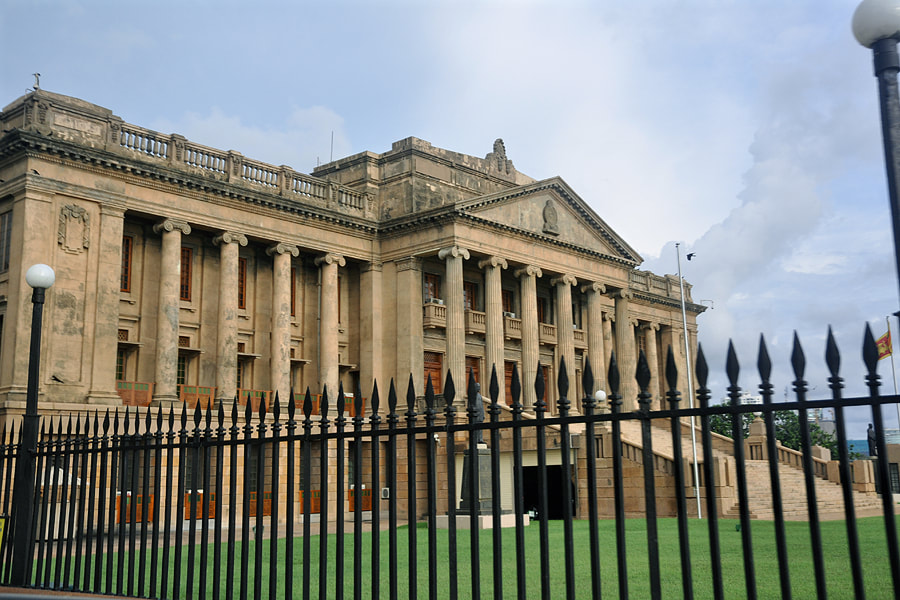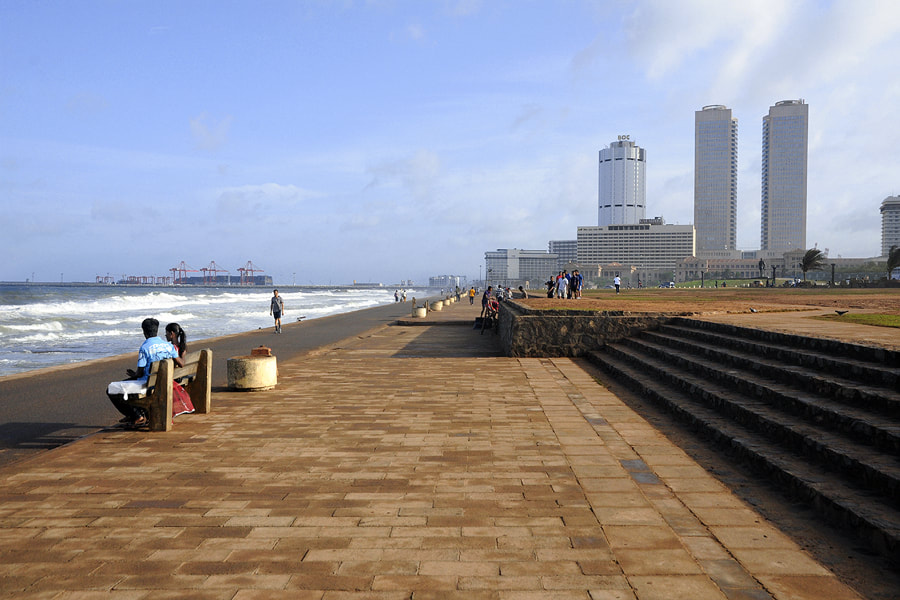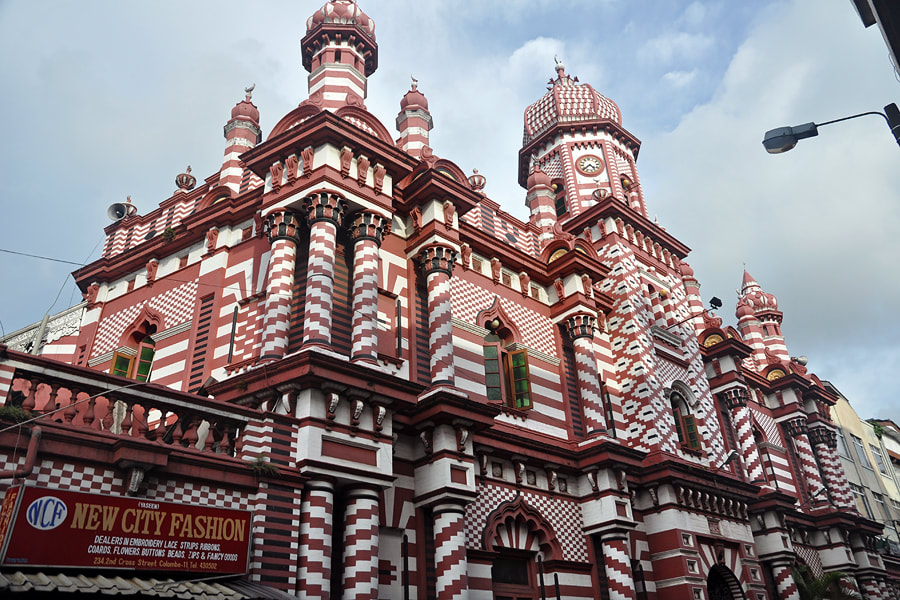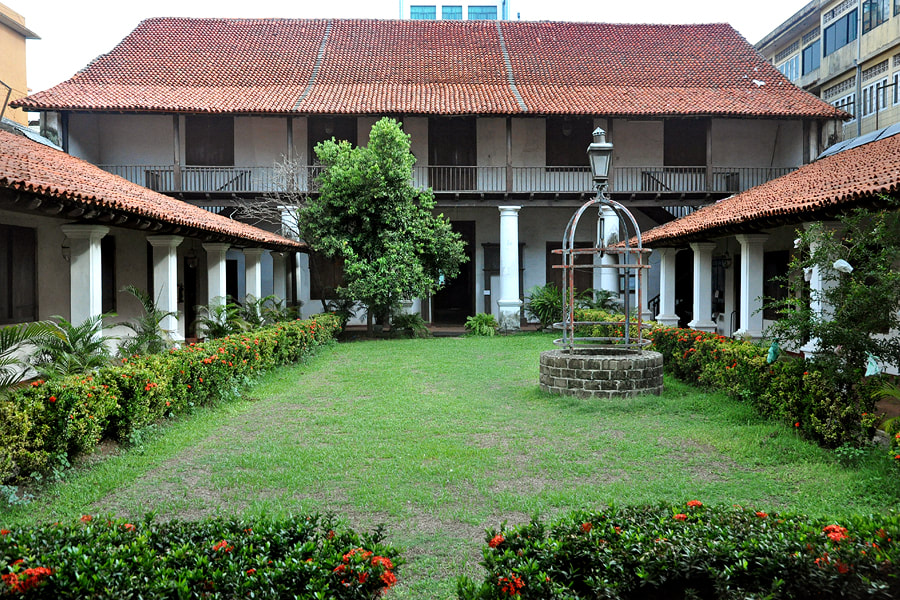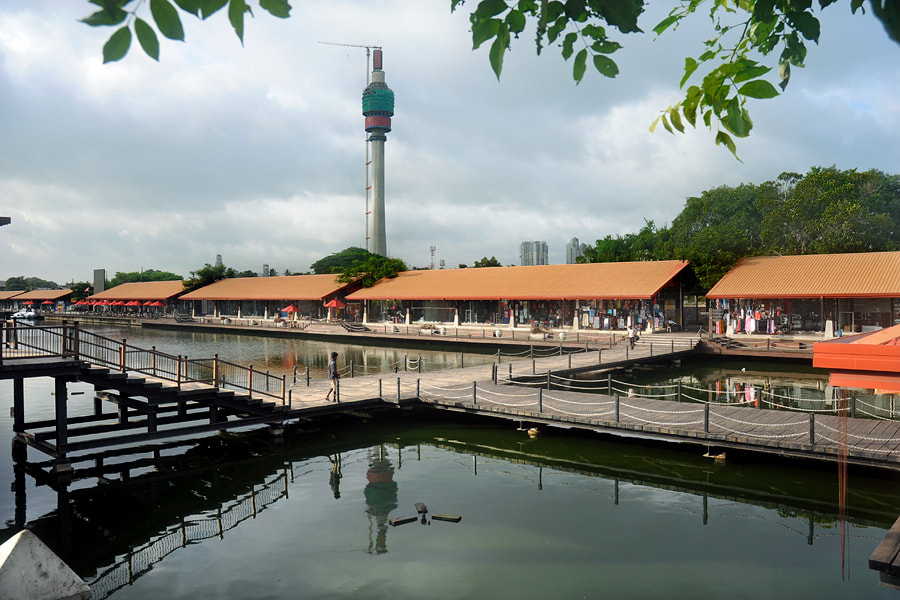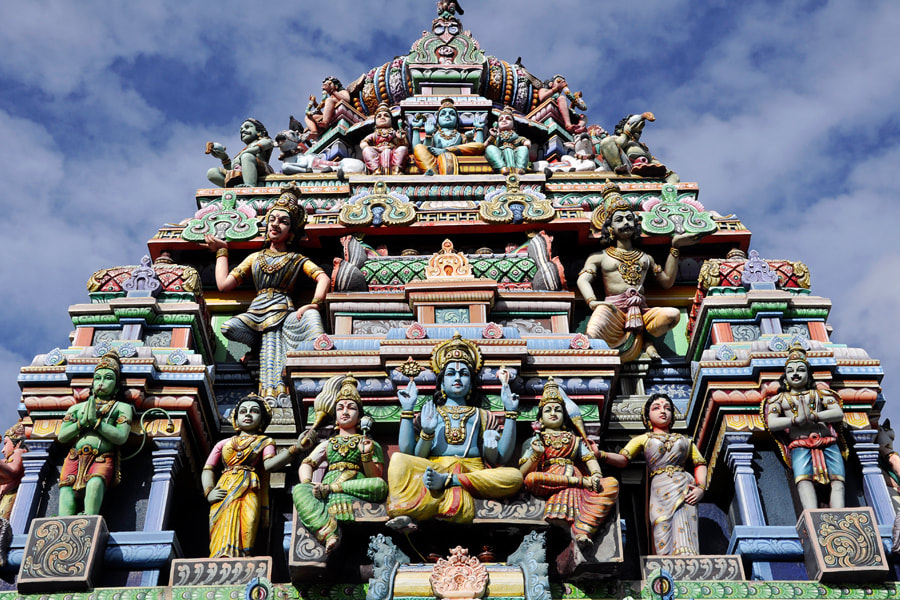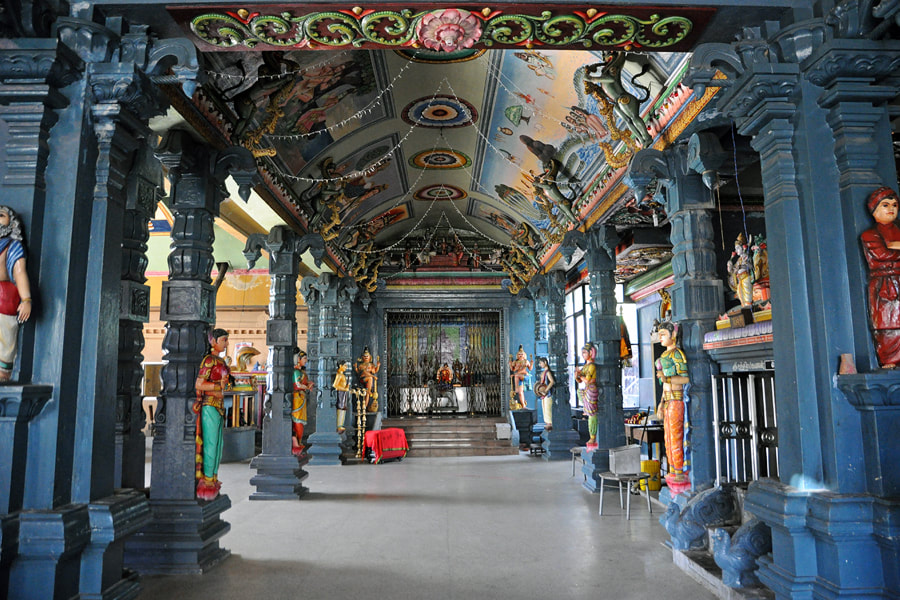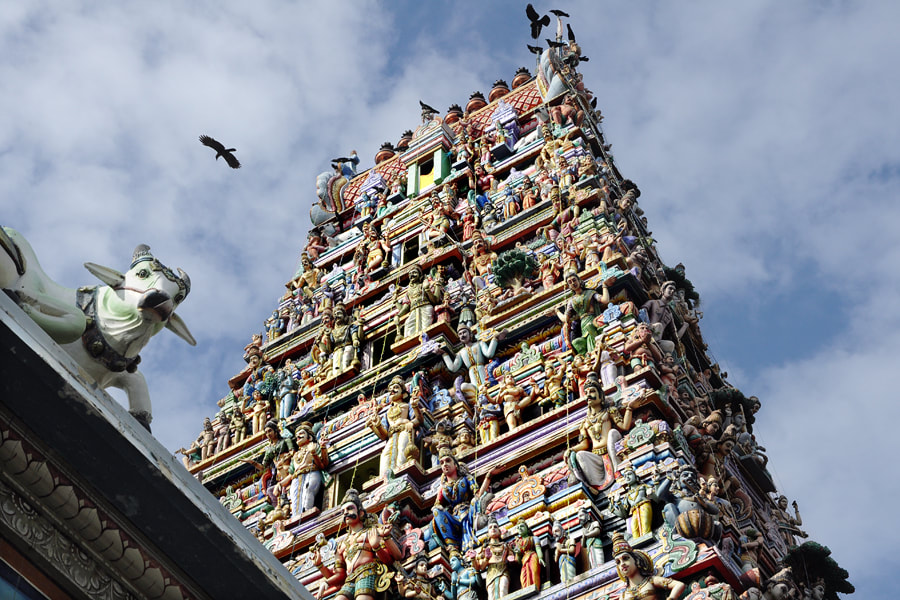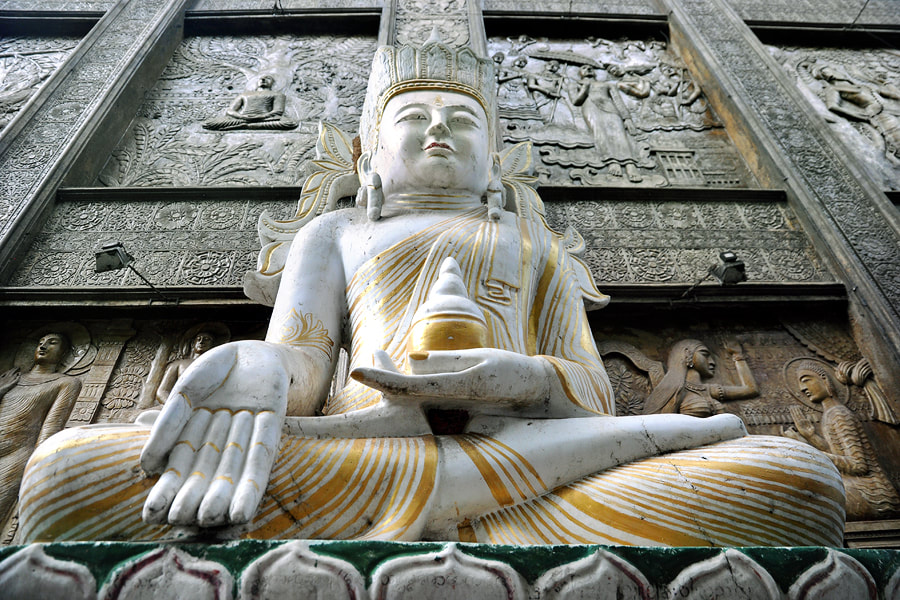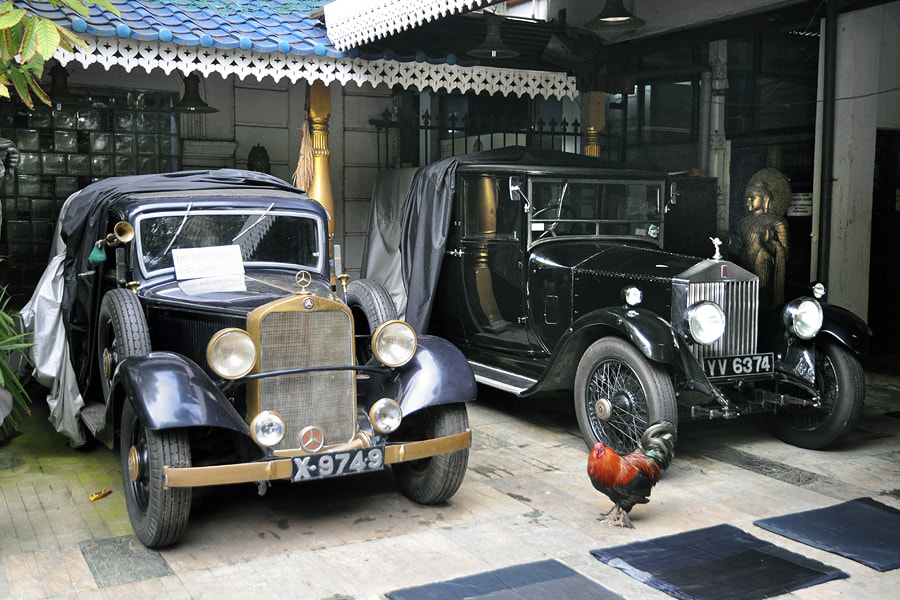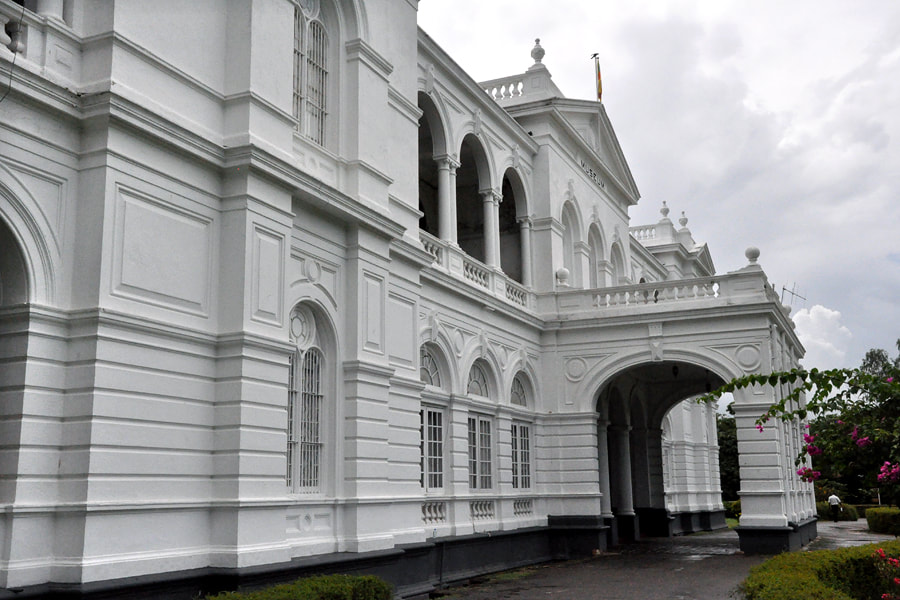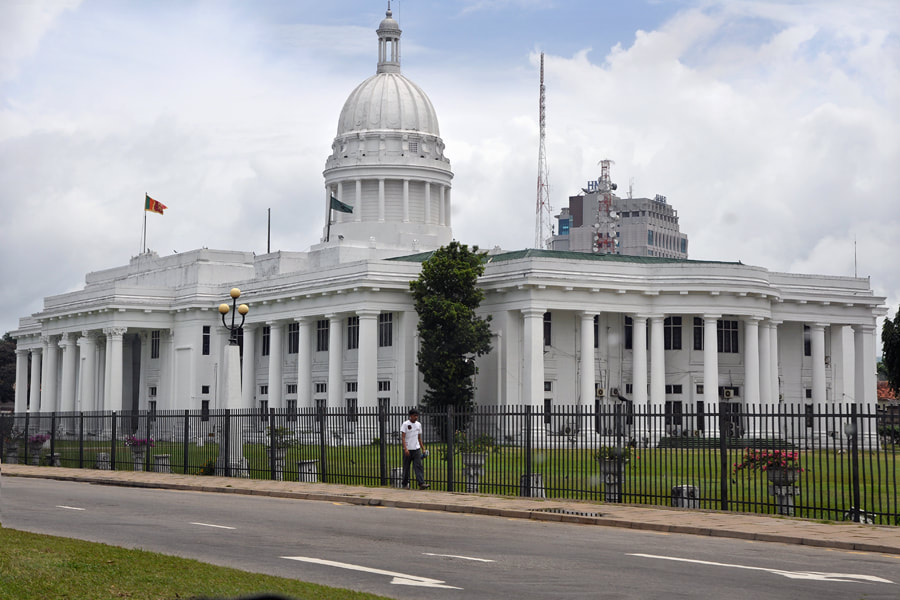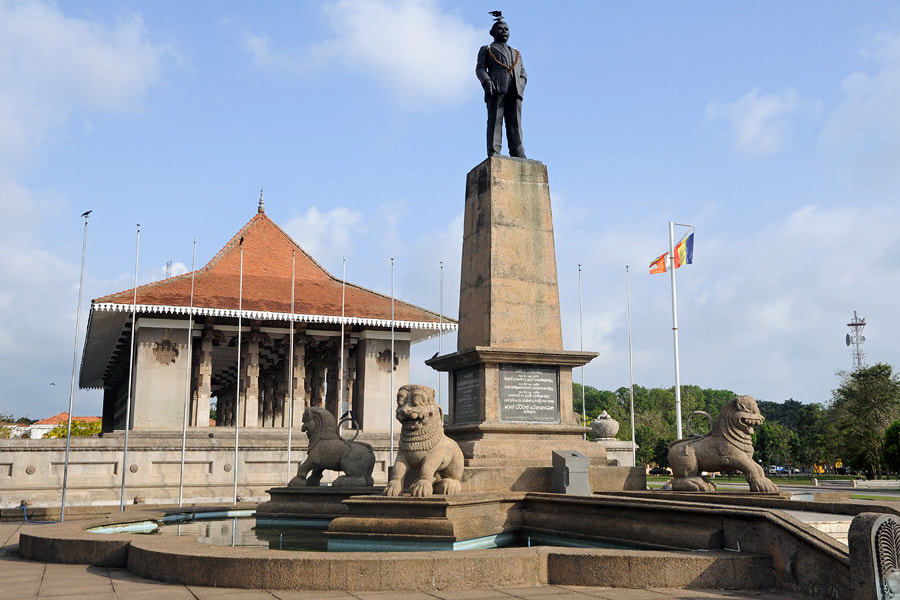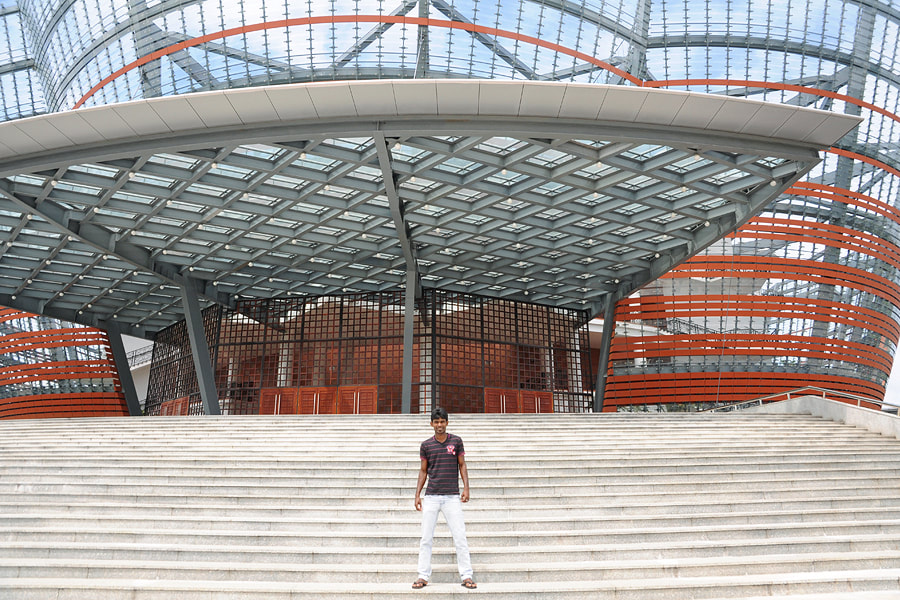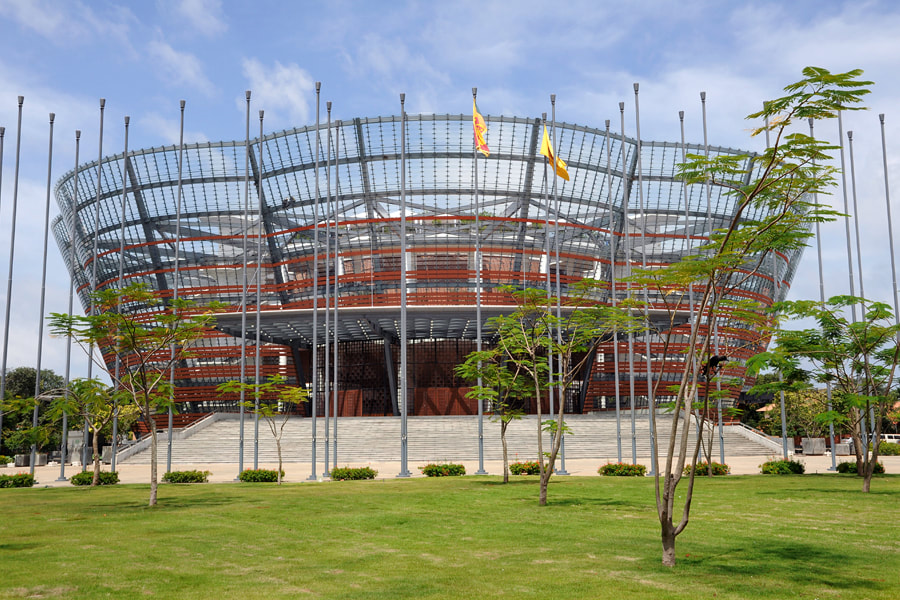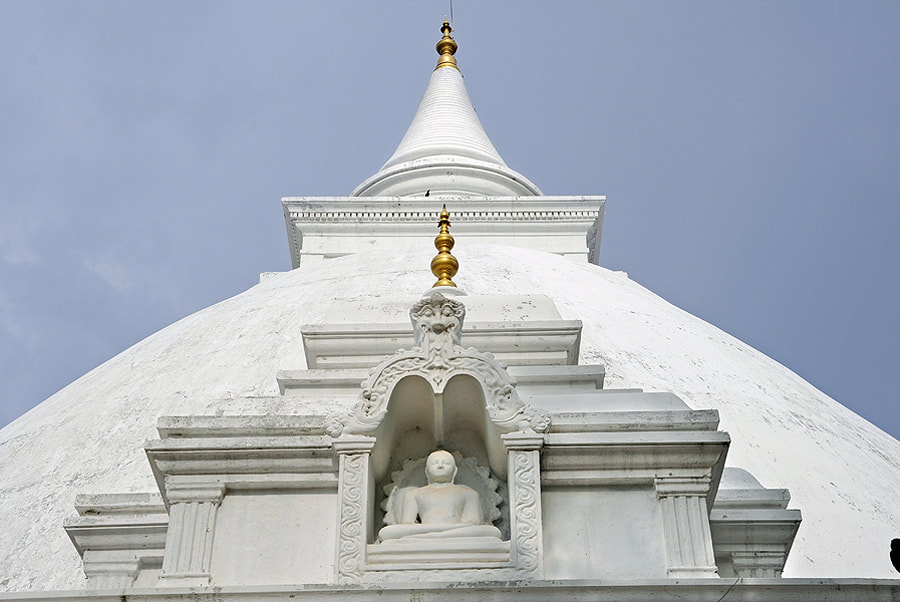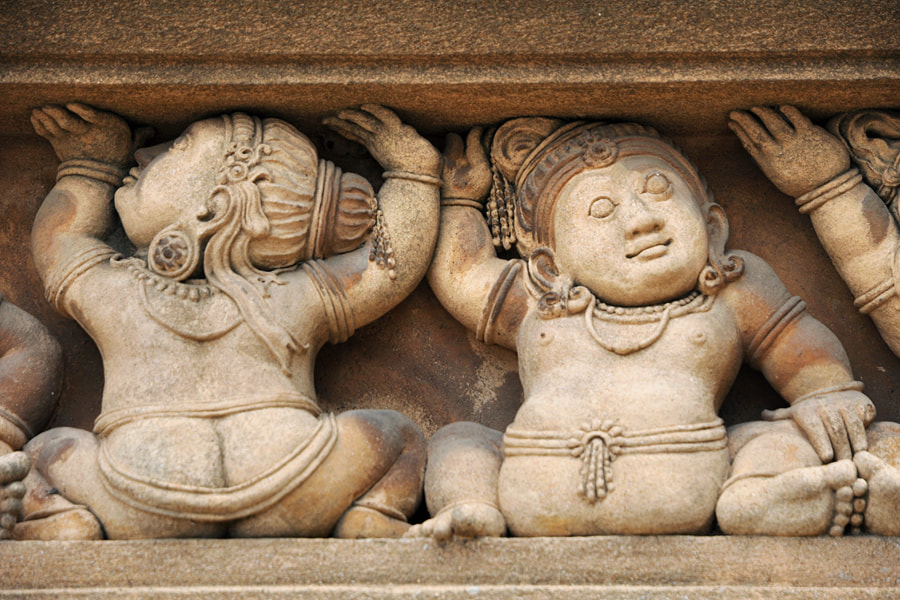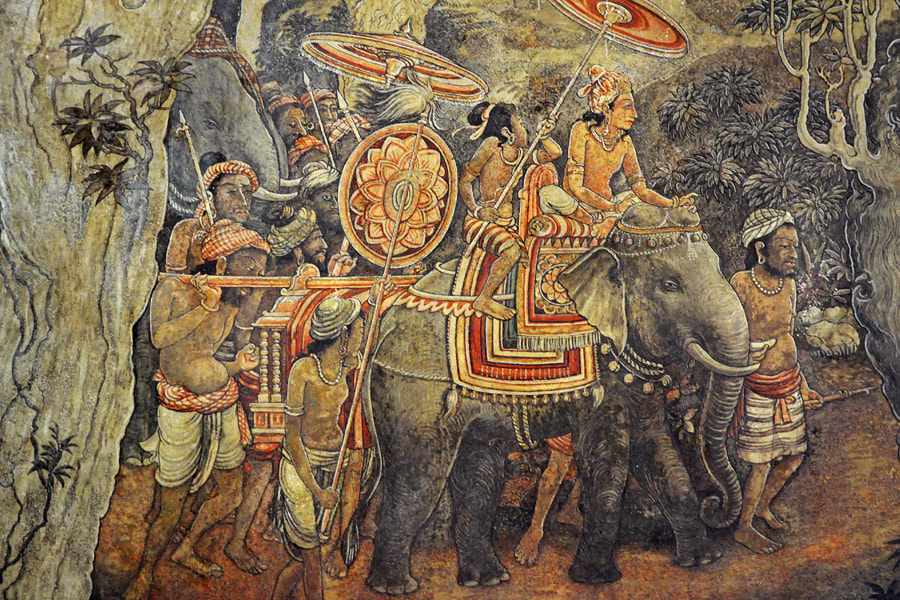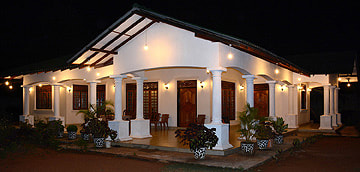To be honest, we do not recommend to visit Colombo as a sightseeing destination during a holiday of only a few weeks. The reason is: Colombo is a traffic jam, noisy and dusty, and every day of your most precious time of the year, when spent in Sri Lanka, can be more delightful and rewarding at other places of interest. Neither has Colombo a historic townscape nor is it crowded with first-class attractions nor is its nightlife amazing. However, it's the de facto capital of the island and by far the largest urban area. For those spending most of their time in Sri Lanka not on an extensive round tour but in one of the beach resorts between Negombo and Hikkaduwa, a one-day excursion to Colombo makes sense. Although it's not Asia's most fascinating metropolis, there is enough to see in Colombo for a day or two. Definitely, Colombo is Sri Lanka's best place for shopping or restaurant visits or taking part in cultural events.
Colombo is the by far the largest city of Sri Lanka. The entire urban area, stretching from Kandana in neighbouring Gampaha District in the north till Panadura in the south and Malabe in the east is inhabited by more than 2 million people. Colombo District, comprising some rural areas further west, has 2.3 million inhabitants. The entire Western Province, including the districts of Colombo, Gampaha and Kalutara, is inhabited by 5.8 million people, more than 25% of Sri Lanka's population. It contributes almost 40% to the GDP and about 80% to the value of industrial productd. There is no other large urban agglomerate of more than 200,000 people on the island. Sri Lanka's largest, second largest, third largest and fifth largest municipalities, namely Colombo, Dehiwala, Moratuwa and Kotte, administered as Divisional Secretariats, all belong the metropolitan area of Colombo (the fourth largest being Negombo). The municipality of Colombo City in a narrow sense, consisting of 15 numbered postal areas, is inhabited by 560.000 persons.
There is no other town in Sri Lanka with such a large scale of ethnicities. Although the largest group are Sinhalese Buddhists, they do not form the majority but only 41% of Colombo's population, compared to 75% Sinhalese Buddhists in the entire island nation. Actually, there are more Tamil than Sinhala native speakers in Colombo City, as not only Sri Lankan Tamils (29%) but also Sri Lankan Moors (23%), so-called Indian Tamils (2%), Chettys (0.1%) and Bharatas (0.1%) speak Tamil dialects. The number of native English speakers is higher than anywhere else in Sri Lanka. Not only Burghers (1%) but also several upper-class people, some Christians in particular, speak English at home. One more minority group playing an important role in the commercial and cultural sectors are the Sri Lankan Malays. Besides Sri Lankan Moors, they form the second largest Muslim minority of Sri Lanka. In fact, many of them prefer to speak English, but they are prowd to have their own language, Sri Lankan Creole Malay, which is basically a Malayan language but with strong Sinhala and Tamil influences. In the 19th century, it was written in a variant of the Arabic alphabeth. Although it is Hambantota that has the highest rate of Sri Lankan Malays (5000 persons, almost 10% of the population), most Sri Lankan Malays live in the urban area of Colombo (about 11,000 in the municipality and 20,000 in the metropolitan area).
Colombo and its suburbs are home to most of Sri Lanka's most renowned private schools and universities as well as upper class clubs. The great majority of Sri Lankan corporations have their head offices in Colombo, particularly those of the tourism industry. Numerous foreign guests of Colombo are business people, more than holiday tourists. That' the reason why Colombo has by far more luxury hotels than any other city in Sri Lanka. Most of Sri Lanka's exhibitions in the commercial sector are held in Colombo. Colombo harbour ranks among the 25 busiest seaports of the world.
The harbour had already been frequented by Muslim seafarers, before it became the prime port and garrison of the Portuguese and subsequently the Dutch colonial rulers of the island. However, it was during the British period that the natural harbour was artificially enlarged and Colombo became the urban centre attracting also more and more Sinhalese and Tamil and Muslim inhabitants of the island. Similarly to the largest urban areas of India and Southeast Asia, Colombo has become a preeminent commercial hub and population centre as late as in the 19th century.
Famous landmarks in Colombo include Galle Face Green, Pettah Market, Wolvendael Church, Beira Lake, Gangaramaya Temple, Viharamahadevi Park, Nelum Pokuna Theatre, National Museum, Independence Square, Dehiwala Zoo and Mount Lavinia Beach.
Colombo is the by far the largest city of Sri Lanka. The entire urban area, stretching from Kandana in neighbouring Gampaha District in the north till Panadura in the south and Malabe in the east is inhabited by more than 2 million people. Colombo District, comprising some rural areas further west, has 2.3 million inhabitants. The entire Western Province, including the districts of Colombo, Gampaha and Kalutara, is inhabited by 5.8 million people, more than 25% of Sri Lanka's population. It contributes almost 40% to the GDP and about 80% to the value of industrial productd. There is no other large urban agglomerate of more than 200,000 people on the island. Sri Lanka's largest, second largest, third largest and fifth largest municipalities, namely Colombo, Dehiwala, Moratuwa and Kotte, administered as Divisional Secretariats, all belong the metropolitan area of Colombo (the fourth largest being Negombo). The municipality of Colombo City in a narrow sense, consisting of 15 numbered postal areas, is inhabited by 560.000 persons.
There is no other town in Sri Lanka with such a large scale of ethnicities. Although the largest group are Sinhalese Buddhists, they do not form the majority but only 41% of Colombo's population, compared to 75% Sinhalese Buddhists in the entire island nation. Actually, there are more Tamil than Sinhala native speakers in Colombo City, as not only Sri Lankan Tamils (29%) but also Sri Lankan Moors (23%), so-called Indian Tamils (2%), Chettys (0.1%) and Bharatas (0.1%) speak Tamil dialects. The number of native English speakers is higher than anywhere else in Sri Lanka. Not only Burghers (1%) but also several upper-class people, some Christians in particular, speak English at home. One more minority group playing an important role in the commercial and cultural sectors are the Sri Lankan Malays. Besides Sri Lankan Moors, they form the second largest Muslim minority of Sri Lanka. In fact, many of them prefer to speak English, but they are prowd to have their own language, Sri Lankan Creole Malay, which is basically a Malayan language but with strong Sinhala and Tamil influences. In the 19th century, it was written in a variant of the Arabic alphabeth. Although it is Hambantota that has the highest rate of Sri Lankan Malays (5000 persons, almost 10% of the population), most Sri Lankan Malays live in the urban area of Colombo (about 11,000 in the municipality and 20,000 in the metropolitan area).
Colombo and its suburbs are home to most of Sri Lanka's most renowned private schools and universities as well as upper class clubs. The great majority of Sri Lankan corporations have their head offices in Colombo, particularly those of the tourism industry. Numerous foreign guests of Colombo are business people, more than holiday tourists. That' the reason why Colombo has by far more luxury hotels than any other city in Sri Lanka. Most of Sri Lanka's exhibitions in the commercial sector are held in Colombo. Colombo harbour ranks among the 25 busiest seaports of the world.
The harbour had already been frequented by Muslim seafarers, before it became the prime port and garrison of the Portuguese and subsequently the Dutch colonial rulers of the island. However, it was during the British period that the natural harbour was artificially enlarged and Colombo became the urban centre attracting also more and more Sinhalese and Tamil and Muslim inhabitants of the island. Similarly to the largest urban areas of India and Southeast Asia, Colombo has become a preeminent commercial hub and population centre as late as in the 19th century.
Famous landmarks in Colombo include Galle Face Green, Pettah Market, Wolvendael Church, Beira Lake, Gangaramaya Temple, Viharamahadevi Park, Nelum Pokuna Theatre, National Museum, Independence Square, Dehiwala Zoo and Mount Lavinia Beach.
Colombo Fort
The Fort of Colombo was originally founded by the Portuguese, it was their power centre on the island. After conquering Colombo in 1656, the Dutch garrison also used Colombo Fort. The British continued to stay in Colombo Fort, it became the centre of colonial administration. The walls of Colombo Fort were demolished in 1870.
The centre of Colombo Fort, also called “Colombo 01” or “Kotuwa”, is marked by the British clock tower. You can not walk far distance in that clocktower area, as it is a high-security zone around the presidential palace, which is hidden in the Gordon Gardens. Only the western and southern parts of Colombo Fort are open to the public.
Colombo Fort is the financial centre of Sri Lanka, where the Ministry of Finance and the Central Bank of Sri Lanka as well as the General Post Office and many of the island’s banks are headquartered. The Colombo Stock Exchange (CSE) is operated in the landmark building of Colombo Fort’s skyline, a pair of twin towers called “World Trade Centre”. A much higher new complex of four towers is planned only a hundred metres further north-east. Colombo Fort’s north-south axis, York Street, is starting here. The short avenue is defined by colonial buildings with arcades. Sri Lanka’s renowned department store Cargills, a red brick building in British colonial style, is located here. The Colombo Port Authority is at the northern end of York Street.
The 3-star Grand Oriental Hotel is situated at that northern part of York Street, too. Another 3-star hotel is the Colombo City Hotel close to the World Trade Centre. There are three 5-star hotels within the same southern part of Colombo Fort, viz. Hilton, Kingsbury and Galadari.
The centre of Colombo Fort, also called “Colombo 01” or “Kotuwa”, is marked by the British clock tower. You can not walk far distance in that clocktower area, as it is a high-security zone around the presidential palace, which is hidden in the Gordon Gardens. Only the western and southern parts of Colombo Fort are open to the public.
Colombo Fort is the financial centre of Sri Lanka, where the Ministry of Finance and the Central Bank of Sri Lanka as well as the General Post Office and many of the island’s banks are headquartered. The Colombo Stock Exchange (CSE) is operated in the landmark building of Colombo Fort’s skyline, a pair of twin towers called “World Trade Centre”. A much higher new complex of four towers is planned only a hundred metres further north-east. Colombo Fort’s north-south axis, York Street, is starting here. The short avenue is defined by colonial buildings with arcades. Sri Lanka’s renowned department store Cargills, a red brick building in British colonial style, is located here. The Colombo Port Authority is at the northern end of York Street.
The 3-star Grand Oriental Hotel is situated at that northern part of York Street, too. Another 3-star hotel is the Colombo City Hotel close to the World Trade Centre. There are three 5-star hotels within the same southern part of Colombo Fort, viz. Hilton, Kingsbury and Galadari.
Colombo Lighthouse
The 29 meter high Colombo Lighthouse, landmark of the waterfont, is situated at Galbokka Point west of colombo Fort and to the south of the port. It replaced an earlier British lighhouse in 1952. At the base is a naval gun battery, two guns of which were brought from Britain in preparation of a visit of then Princess Elizabeth, who had to cancel the tour due to her father's death. The battery is used by the Sri Lanka Navy for ceremonial gun salutes, particulalry on Independence Day (4th February).
The vistas from the viewing gallery of the lighthouse are amazing, the growing skyline of Colombo can be seen from here. Access is free. The lighthouse area would be replaced by the planned “Port City”, in case this artificial peninsula of Colombo should ever be built.
The vistas from the viewing gallery of the lighthouse are amazing, the growing skyline of Colombo can be seen from here. Access is free. The lighthouse area would be replaced by the planned “Port City”, in case this artificial peninsula of Colombo should ever be built.
Galle Face Green
Just to the south of Colombo Fort's marine drive, Galle Face Green, also known simply as Galle Face, is the capital's famous beach promenade and the largest open space in the centre of the city. It is a half-kilometre long lawn running between the open sea and Galle Road, stretching from the newly restored Galle Face Hotel at the southern end to the south-western edge of Colombo Fort. Colombo’s landmark edifice in a neoclassic style, the Old Parliament Building (now Presidential Secretariat of Sri Lanka), marks the joint between Colombo Fort and Galle Face Green.
Amongst locals and tourists alike, the promenade is Colombo`s favoured picnic spot, although bathing in the sea is much too dangerous here, due to high waves and underwater currents. The green space can seem more brown and dusty than green, at least at the end of the dry season in April and May. Due to regular heavy winds, kite flyers can often be seen on the lawn and the annual Colombo kite festival takes place here, too. Particularly at weekend and around sunset, families gather to play or take dinner. Just in between the lawn and the seashore, there is a narrow concrete stripe, with softdrink and take-away food and souvenir stalls as well as toy and balloon and kite sellers. It is also a favourite venue for courting couples on a date. Like in Italy, people put on their best clothes to go for a promenade along the seafront.
Colombo’s beach promenade, previously a marshland, was initially laid out in 1859 by Sir Henry Ward, then Governor of Ceylon. The British and local elites used is for horse racing or otherwise as a golf course. It was also the first cricket ground on the island and thus is the most significant national heritage site for sportive Sri Lankans, so to speak. The British, sadly enough, used Galle Face Green for public executions, too. Maybe this is one reason why it later on gained a name as the rallying place for the left movement. The Galle Face Green Promenade is reopened to the public since 2001. The largest event celebrated at Galle Face Green was a mass with the Pope Francis on 14. Januar 2015, canonizing the "apostle of Ceylon", St. Joseph Vaz.
Littering, nuisance, vehicles, chairs, advertisements, sports, and even heavy shoes on grass areas are prohibited.
If you are looking for the perfect public place to join New Year celebrations and enjoy fireworks in Sri Lanka, Galle Face Green is the best choice.
Amongst locals and tourists alike, the promenade is Colombo`s favoured picnic spot, although bathing in the sea is much too dangerous here, due to high waves and underwater currents. The green space can seem more brown and dusty than green, at least at the end of the dry season in April and May. Due to regular heavy winds, kite flyers can often be seen on the lawn and the annual Colombo kite festival takes place here, too. Particularly at weekend and around sunset, families gather to play or take dinner. Just in between the lawn and the seashore, there is a narrow concrete stripe, with softdrink and take-away food and souvenir stalls as well as toy and balloon and kite sellers. It is also a favourite venue for courting couples on a date. Like in Italy, people put on their best clothes to go for a promenade along the seafront.
Colombo’s beach promenade, previously a marshland, was initially laid out in 1859 by Sir Henry Ward, then Governor of Ceylon. The British and local elites used is for horse racing or otherwise as a golf course. It was also the first cricket ground on the island and thus is the most significant national heritage site for sportive Sri Lankans, so to speak. The British, sadly enough, used Galle Face Green for public executions, too. Maybe this is one reason why it later on gained a name as the rallying place for the left movement. The Galle Face Green Promenade is reopened to the public since 2001. The largest event celebrated at Galle Face Green was a mass with the Pope Francis on 14. Januar 2015, canonizing the "apostle of Ceylon", St. Joseph Vaz.
Littering, nuisance, vehicles, chairs, advertisements, sports, and even heavy shoes on grass areas are prohibited.
If you are looking for the perfect public place to join New Year celebrations and enjoy fireworks in Sri Lanka, Galle Face Green is the best choice.
Port City - planning a new Colombo... or maybe not
There are altered plans to create a 16th neigbourhood called “Colombo Port City”. More than 250 hectares of additional land will form an artificial peninsula to the west of Colombo Fort. The ensuing project would become the largest infrastructure undertaking in Sri Lanka's modern history. President Mahinda Rajapaksa and Chinese President Xi Jinping inaugurated the Colombo Port City Project already in September 2014. After Mahinda Rajapaksa was not reelected in 2015, the Port City Project was suspended. In 2016, it was replaced by a new concept of developing an international financial centre. The reason for the resumption of the controversial construction works appears to be the governments intention not to disgruntle the main investor, China.
The modern quarter will completely change the layout and skyline of Colombo. Colombo will grow into the ocean and will get a new centre of international standards - when or if the constructions will be completed.
The modern quarter will completely change the layout and skyline of Colombo. Colombo will grow into the ocean and will get a new centre of international standards - when or if the constructions will be completed.
|
"Backtracking from its pre-election announcement on scrapping the Chinese-funded port city in Colombo, the Sri Lankan Government on Thursday said it would go ahead with the $1.34-billion project."
This is the beginnig of an article of the Indian newspaper "The Hindu", published last Thursday, 5th of February 2015. cited from "The Hindu": http://www.thehindu.com/news/international/south-asia/sri-lanka-to-go-ahead-with-chinesefunded-port-city-in-colombo/article6861236.ece |
another project delayed or cancelled - Krrish Towers
Colombo’s skyline is growing every year, but still the 152 m high twin towers of Colombo’s World Trade Centre are the most prominent buildings, with a height of 152 m.
However, in short distance from Colombo’s WTC, a new mega project was launched that will overshadow their dimensions and even surpass the New York Freedom tower (415 m). Colombo’s future landmark is planned by the Krrish Group, an Indian real-estate company. The Krrish Square is ranked as one of the largest skyscraper projects in the world. Four supertall towers will be built here, the largest one for commercial purposes shall house offices and a 7-star hotel. Completion of this tower 1 was scheduled for 2018.
But it is uncertain whether this mega project will be started at all. The Krrish Group did not begin its construction work by the stipulated time period in 2012. This resulted in a controversy about “broken promises”. Since March 2013, the project has been frozen as the company has not yet honoured its payments to the Urban Development Authority. The Sri Lankan Government is considering to hand over the land to another investor. But in 2016 , Krrish was supported by the US-based Ritz-Carlton hotel company. The project seems to have been downsized to only two towers with a maximum of 70 storeys.
However, in short distance from Colombo’s WTC, a new mega project was launched that will overshadow their dimensions and even surpass the New York Freedom tower (415 m). Colombo’s future landmark is planned by the Krrish Group, an Indian real-estate company. The Krrish Square is ranked as one of the largest skyscraper projects in the world. Four supertall towers will be built here, the largest one for commercial purposes shall house offices and a 7-star hotel. Completion of this tower 1 was scheduled for 2018.
But it is uncertain whether this mega project will be started at all. The Krrish Group did not begin its construction work by the stipulated time period in 2012. This resulted in a controversy about “broken promises”. Since March 2013, the project has been frozen as the company has not yet honoured its payments to the Urban Development Authority. The Sri Lankan Government is considering to hand over the land to another investor. But in 2016 , Krrish was supported by the US-based Ritz-Carlton hotel company. The project seems to have been downsized to only two towers with a maximum of 70 storeys.
Pettah and its market
If you are looking for a touch of Indian hurly-burly in Sri Lanka, Colombo’s local market and trading area Pettah is the best place to experience a kind of oriental bazaar in Sri Lanka. The name of Pettah is derived from both the Tamil “pittai” and Sinhala "pita kotuwa" meaning “outer fort” or, more precisely, “outside the fort”. Pettah’s administrative name is Colombo 11.
Pettah in the immediate neighbourhood of the mondane Colombo Fort is the sharpest contrast you can imagine. The streets are narrow and crowded with people and clogged with tuk-tuks. Besides market stalls and small shops and motor vehicles you will see many “coolies” pulling overladen carts. By the way, the word is derived from the Tamil language.
Most traders in Pettah speak Tamil but are Muslims (Moors and Memons). However, there are significant Tamil and Sinhalese groups and minorities such as malays and Burghers, too. Pettah is not dominated by one single ethnic group, it is a centre of multi-culturalism. In this part of Colombo, you will find even more Hindu temples such as the New Katherisan Kovil than mosques.
Jami ul-Alfar is the most eye-catching Muslim place of worship, also called the “Red Mosque”. It is one of the oldest and most visited mosques in Colombo. Jami ul-Alfar in Pettah was built in 1909. It was a kind of landmark of Colombo in the early 20th century.
Similar to other oriental bazaars, shops selling similar kinds of goods tend to be grouped together. For example in Sea Street, there are dozens of jewelry stores side-by-side. Close-by is the Ayurvediv market. Fruits and vegetables are sold in a roofed market hall just south of the colonial town hall.
Pettah in the immediate neighbourhood of the mondane Colombo Fort is the sharpest contrast you can imagine. The streets are narrow and crowded with people and clogged with tuk-tuks. Besides market stalls and small shops and motor vehicles you will see many “coolies” pulling overladen carts. By the way, the word is derived from the Tamil language.
Most traders in Pettah speak Tamil but are Muslims (Moors and Memons). However, there are significant Tamil and Sinhalese groups and minorities such as malays and Burghers, too. Pettah is not dominated by one single ethnic group, it is a centre of multi-culturalism. In this part of Colombo, you will find even more Hindu temples such as the New Katherisan Kovil than mosques.
Jami ul-Alfar is the most eye-catching Muslim place of worship, also called the “Red Mosque”. It is one of the oldest and most visited mosques in Colombo. Jami ul-Alfar in Pettah was built in 1909. It was a kind of landmark of Colombo in the early 20th century.
Similar to other oriental bazaars, shops selling similar kinds of goods tend to be grouped together. For example in Sea Street, there are dozens of jewelry stores side-by-side. Close-by is the Ayurvediv market. Fruits and vegetables are sold in a roofed market hall just south of the colonial town hall.
Dutch colonial buildings in Pettah
However, right in the middle of Pettah is a haven of peace and tranquility, the Dutch colonial museum. It is a former Dutch colonial residence, the four wings of the building surround a small garden, which is calm and picturesque. The museum is crowded with colonial furniture and information on colonial history, particularly cinnamon trade.
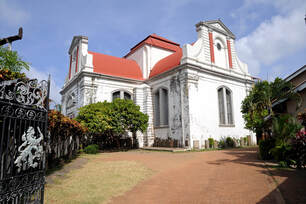
A little bit east of the Pettah market area is Colombo’s oldest church, the Dutch Reformist Wolvendaal Church. As the earlier Kasteel Church within Colombo Fort was demolished in 1813, Wolvendaal Church, built from 1749 till 1757, is Sri Lanka's oldest Protestant church still in use and thereby one of the island's most important Dutch colonial buildings. The Dutch named the area “wolf’s dale”, or Wolvendaal after after jackals roaming there. The new enlarged church building, situated outside the fortifications of Colombo, was constructed on a hillock near the harbour in such a way that ships approaching Colombo could easily sight it. The Wolvendaal church was the island's principal place of Christian worship till the end of Dutch rule and continues to be used by the Dutch Reformed Church.
Floating Market near Olcott Street
Many guests of Colombo will remember the noisy Bastian Mawatha Bus Station in Colombo, though not knowing this name. It’s just south of Central Bus Station, supplementing it, at the opposite side of the main road called Olcott Street. Buses to southern parts of Sri Lanka and most city buses start at Bastian Mawatha Station.
This dusty crowded bus station has not been the neatest part of Sri Lanka. But here, in the very centre of Colombo, in the immediate neighbourhood of the Colombo Fort Railway Station, in between bus station and railway lines, there is now a quite smart new shopping mall, which actually is a new attraction of Sri Lanka: a floating market. It is part of the city beautification program and a project developing Bastian Street as a green environment.
A part of the Beira Lake, the basin paralling Bastian Street and railway line, once infested with algae and full of rubble, has become Sri Lanka’s first loating market on a branch of the Beira lake facing the Bastian road. The complex has about 100 stalls which sell local goods including vegetables and handicraft and. Some old but worn-down abandoned buildings have been integretated. The area also has restaurant and public convenience facilities.
This is a pleasant kind of tradtional shopping mall in a modern environenment, visited by locals in the first place. But it’s a new tourist destination, too. Many private travellers coming to Colombo’s bus stations for a stopover will appreciate the new setting. And the local ambiente really makes a difference, if you compare it to Thailand’s floating market’s that are 100% tourism industry fake. The Colombo floating market may be not really show trade from boat to boat or from boat to stall, so the term “floating market” is a little bit misleading. However, it’s a place to see genuine Sri Lankan market life and not only souvenir sellers. So have a look, when you are in Colombo!
This dusty crowded bus station has not been the neatest part of Sri Lanka. But here, in the very centre of Colombo, in the immediate neighbourhood of the Colombo Fort Railway Station, in between bus station and railway lines, there is now a quite smart new shopping mall, which actually is a new attraction of Sri Lanka: a floating market. It is part of the city beautification program and a project developing Bastian Street as a green environment.
A part of the Beira Lake, the basin paralling Bastian Street and railway line, once infested with algae and full of rubble, has become Sri Lanka’s first loating market on a branch of the Beira lake facing the Bastian road. The complex has about 100 stalls which sell local goods including vegetables and handicraft and. Some old but worn-down abandoned buildings have been integretated. The area also has restaurant and public convenience facilities.
This is a pleasant kind of tradtional shopping mall in a modern environenment, visited by locals in the first place. But it’s a new tourist destination, too. Many private travellers coming to Colombo’s bus stations for a stopover will appreciate the new setting. And the local ambiente really makes a difference, if you compare it to Thailand’s floating market’s that are 100% tourism industry fake. The Colombo floating market may be not really show trade from boat to boat or from boat to stall, so the term “floating market” is a little bit misleading. However, it’s a place to see genuine Sri Lankan market life and not only souvenir sellers. So have a look, when you are in Colombo!
Kaleshvaram Kovil in Captain's Garden
Just behind the Fort Railway Station and the Pettah Flaoting Market is the Sri Kaleshwaram Kovil, also spelt Sri Kaileswaram, the name Kailash, which is the mountain abode of Lord Shiva, indicates that this temple is dedicated to the supreme deity venerated in the Hindu faith of Tamils. Besides Shiva, also his son Ganesha has a shrine in the temple compound. The Kaleshwaram Kovil is sometimes confused with the nearby Sri Kailawasanathan Swami Devasthanam Kovil, which is situated at the opposite side of Beira Lake in the neighbourhood of Slave Island, more precisely, between Murugan Street and Kew Passage. The Kaleshvaram Kovil, however, belongs to the neighbourhood of Pettah, though it cannot be reached from Pettah Market directly. In fact, it's easier to visit the temple coming from the Maradana Railway Station further southeast than from the Fort Railway Station. The temple is located at the temple road, which branches off from Wijewardene Mawatta, the latter being the street running along the northern shores of Beira Lake. This area just to the south of the railway line and to the north of Beira Lake is known as Captain's Garden. Accordingly, the Kaleshwaram Kovil is also knownn The Captain's Garden Hindu Temple in English.
The Kaleshwaram Kovil's Gopuram, a Drawidian-style gateway tower typical of South India's and Sri Lanka's Hindu temples, is one of the largest and most colourful in Colombo. The temple is one of the many claiming to be the oldest sanctuary in the city. The buildings and decorations, however, are mostly from recent decades. The sanctuary is older, Hindu Tamil traders from South India came here to worship after docking.
In contrast to many other Tamil temples, tourists are allowed to enter the interior of the temple and to take pictures of the temple courtyard. It's not permitted to shoot photos of the shrine room. Visitors have to be properly dressed and to pay a small fee for the photo permission.
The Kaleshwaram Kovil's Gopuram, a Drawidian-style gateway tower typical of South India's and Sri Lanka's Hindu temples, is one of the largest and most colourful in Colombo. The temple is one of the many claiming to be the oldest sanctuary in the city. The buildings and decorations, however, are mostly from recent decades. The sanctuary is older, Hindu Tamil traders from South India came here to worship after docking.
In contrast to many other Tamil temples, tourists are allowed to enter the interior of the temple and to take pictures of the temple courtyard. It's not permitted to shoot photos of the shrine room. Visitors have to be properly dressed and to pay a small fee for the photo permission.
Slave Island within Beira Lake
Slave Island, also called Colombo 02, is the area immediately south of the Colombo Fort. The quarter is surrounded by branches of the Beira Lake. The name “Slave Island” is from the colonial period. This area enclosed by canals and lakes was used to confine African slaves. It is said that the colonial rulers filled the canals with crocodiles. Slaves from Africa were not only deported to American colonies but also, in almost even high numbers, to Asian colonies. However, most of the slaves confined in Colombo returned to Africa later on. Only a very small group of African descendants, so-called Kaffirs, lives in Sri Lanka today. Colombo’s Slave Island has become a commercial area with shopping centres and some first-class hotels. Besides Sinhalese, many Muslims live in this quarter of Colombo.
Subramaniya Kovil in the Slave Island neighbourhood
Sri Subramaniya Kovil, one of the capital’s most impressive Tamil temples, is situated in the eastern half of Slave Island, not far from the Masjidul Akbar mosque. The Sri Subramaniya temple is in the typical Tamil style. The landmarks of Tamil temples are entrance gate towers called Gopurams. They are extremely colourful. Literally hundreds of sculptures depicting deities and other mythological figures are seen on the levels of the steep step pyramidic structure. The Gopuram of Colombo’s Subramaniya temple ist 25 m high.
Subramaniya is the warrior god, son of Shiva, who is known as Skanda, Kartikkeya, Murugan or Kataragama in different parts of India, particularly venerated by Tamils. This is why he is often referred to as “Tamil Kadavul”, meaning “God of Tamils”. Indeed, Tamils worshipped a hill deity called Murugan already before the “Sanskritisation” of their religion by Brahmin priests of North-Indian origin, who identified this local god with the son of Shiva. Under the name of Kataragama the very same god is venerated by Sinhalese Buddhists, too.
Please don`t forget to remove your shoes before entering a Hinsu or Buddhist sanctuary. Usually foreigners are allowed to see the ceremonies. However, in order to be polite you should not take photo’s without asking a priest or a waiter for permission.
Subramaniya is the warrior god, son of Shiva, who is known as Skanda, Kartikkeya, Murugan or Kataragama in different parts of India, particularly venerated by Tamils. This is why he is often referred to as “Tamil Kadavul”, meaning “God of Tamils”. Indeed, Tamils worshipped a hill deity called Murugan already before the “Sanskritisation” of their religion by Brahmin priests of North-Indian origin, who identified this local god with the son of Shiva. Under the name of Kataragama the very same god is venerated by Sinhalese Buddhists, too.
Please don`t forget to remove your shoes before entering a Hinsu or Buddhist sanctuary. Usually foreigners are allowed to see the ceremonies. However, in order to be polite you should not take photo’s without asking a priest or a waiter for permission.
Seema Malaka in Beira Lake
Seema Malaka, also spelt Simamalaka or Sima Malakaya, is an elegant island temple in the middle of the small Beira Lake, which is located at the southern edge of Colombo 02 (Slave Island). For art lovers, it is one of the few Buddhist temples in Colombo woth a visit, famous for its stepped wall of Buddhist statues. Some of them have their hands on their lap, while some show other gestures.
The original Seema Malaka temple from the 19th century had sunk into the lake. In the 1970s Ceylon’s most renowned modern architect, Geoffrey Bawa, designed the new Seema Malaka island temple. Remarkably, the construction was sponsored by a Muslim, namely S.H. Mososajee, the chairman of Moosajees Ltd., a specialists in fiber and forage.
The Seema Malaka is built on three raised platforms, connected to one another and to the mainland by bridges. Bawa’s design echoed ancient forest monasteries, such as the Western temples of Anuradhapura, which were bound together by walkways, too. The halls of Seema Malaka are in the Kandyan style, with typical overhanging roofs.
The original Seema Malaka temple from the 19th century had sunk into the lake. In the 1970s Ceylon’s most renowned modern architect, Geoffrey Bawa, designed the new Seema Malaka island temple. Remarkably, the construction was sponsored by a Muslim, namely S.H. Mososajee, the chairman of Moosajees Ltd., a specialists in fiber and forage.
The Seema Malaka is built on three raised platforms, connected to one another and to the mainland by bridges. Bawa’s design echoed ancient forest monasteries, such as the Western temples of Anuradhapura, which were bound together by walkways, too. The halls of Seema Malaka are in the Kandyan style, with typical overhanging roofs.
Gangaramaya Temple
The Simalaka shrine is the ordination hall of the close-by Buddhist Gangaramaya temple, pronounced and also spelt Gangarama. This monastery situated just 200 m south of Beira Lake is the most famous and touristically most frequented Buddhist temple within the municipality of Colombo. For locals, its an educational centre with an attached orphanage and a library in the first place.
Foreigners appreciate the somewhat freakishly collections in the exhibition halls, one Buddha statue is wearing sunglasses. Actually, large parts of the temple are a museum showcasing Buddha statues from various parts of Asia, including the island's smallest Buddha sculpture, along with statues of Hindu deities. It also displays the culture of Sinhalese life in Colombo during the modern period, including traditional furniture, Dutch period coins, old watches, bejewelles trinkets, and even vintage cars such as Mercedes and Rolls-Royce.
Gangaramaya sustains an elephant named Ganga as a permanent resident.
Gangaramaya's main shrine, decorated in soft yellowish hues, shelters a huge Buddha statue in Samadhi Mudra, flanked by sculptures of divine or semi-divine beings. The ceilings are decorated with paintings depicting Buddhist stories.
The most distinguished architectural feature in the courtyards of the temple complex is a stepped pyramid with many Budddha statues and mini stupas on each level, resembling the famous Borobudur temple mound in central Java, Indonesia.
The temple was donated by a famous shipping merchant in the late 19th century, who carried the heriditary title of a Mudaliyar, which had been transferred by the Governors of Ceylon to wealthy families loyal to the British crown.
The current chief monk, Ven. Galaboda Gnanissara Thero, who plays a significant role in Sri Lankan politics, assumed the administration of the Gangaramaya as a 16-year-old novice monk. Many of the items exhibited in the museum of the Gangaramaya Temple are from his private collection.
The Gangaramaya Temple is the focus of the annual Navam Perahera culminating on the full-moon day in February (Navam Poya).
Foreigners appreciate the somewhat freakishly collections in the exhibition halls, one Buddha statue is wearing sunglasses. Actually, large parts of the temple are a museum showcasing Buddha statues from various parts of Asia, including the island's smallest Buddha sculpture, along with statues of Hindu deities. It also displays the culture of Sinhalese life in Colombo during the modern period, including traditional furniture, Dutch period coins, old watches, bejewelles trinkets, and even vintage cars such as Mercedes and Rolls-Royce.
Gangaramaya sustains an elephant named Ganga as a permanent resident.
Gangaramaya's main shrine, decorated in soft yellowish hues, shelters a huge Buddha statue in Samadhi Mudra, flanked by sculptures of divine or semi-divine beings. The ceilings are decorated with paintings depicting Buddhist stories.
The most distinguished architectural feature in the courtyards of the temple complex is a stepped pyramid with many Budddha statues and mini stupas on each level, resembling the famous Borobudur temple mound in central Java, Indonesia.
The temple was donated by a famous shipping merchant in the late 19th century, who carried the heriditary title of a Mudaliyar, which had been transferred by the Governors of Ceylon to wealthy families loyal to the British crown.
The current chief monk, Ven. Galaboda Gnanissara Thero, who plays a significant role in Sri Lankan politics, assumed the administration of the Gangaramaya as a 16-year-old novice monk. Many of the items exhibited in the museum of the Gangaramaya Temple are from his private collection.
The Gangaramaya Temple is the focus of the annual Navam Perahera culminating on the full-moon day in February (Navam Poya).
Cinnamon Gardens neighbourhood of Colombo
Cinnamon Gardens is a quarter of Colombo, 3 kilometers south-east from Colombo Fort and immediately south of Slave Island (Colombo 02) and Maradana (Colombo 10). The northern end of Cinnamon Gardens is the Viharamahadevi Park, formerly known as Victoria Park. Cinnamon Gardens is named after a former Cinnamon plantation in this area. Cinnamon Gardens is predominantly Sinhalese but with an above-average percentage of Tamils.
Most Colombo city tours cross Cinnamon Gardens, because many of Colombo’s landmark buildings from the colonial period and from the modern independent era belong to Cinnamon Gardens (Colombo 07), namely Colombo Town Hall, the National Museum, the Prime Minister's Office, Independence Square, Bandaranaike Memorial Hall and Nelum Pokuna Mahinda Rajapakse Theatre. The University of Colombo and the Sirimavo Bandaranaike Vidyalaya form the south-western corner of Cinnamon Gardens. Many more renowned schools and numerous foreign embassies are located in this greenest part of Colombo, too.
Most Colombo city tours cross Cinnamon Gardens, because many of Colombo’s landmark buildings from the colonial period and from the modern independent era belong to Cinnamon Gardens (Colombo 07), namely Colombo Town Hall, the National Museum, the Prime Minister's Office, Independence Square, Bandaranaike Memorial Hall and Nelum Pokuna Mahinda Rajapakse Theatre. The University of Colombo and the Sirimavo Bandaranaike Vidyalaya form the south-western corner of Cinnamon Gardens. Many more renowned schools and numerous foreign embassies are located in this greenest part of Colombo, too.
Independence Square in Colombo
Independence Square, formerly known as Torrington Square, in the neighbourhood of Cinnamon Gardens is the must attractive public place in Colombo. The national monument of the Independence Memorial Hall, also known as Independence Commemoration Hall, is located at it's centre. Independence day on 4th February 4 and swearing-in cermeonies of new Presidents are held in this hall. The hall also houses the Independence Memorial Museum. The monument is built at the location where the formal independence ceremony terminating the British rule took place in 1948. The formal ceremony marking the start of self-rule, with the opening of the first parliament at the special podium at the present Independence Square, Colombo. The design of the building is based on the Audience Hall between Royal Palace anr Tooth Temple in Kandy.
National Museum in Colombo
The main National Museum of Sri Lanka, which has now branch museums in other towns, was established as Colombo Museum in 1877, opened by Sir William Henry Gregory, then British Governor of Ceylon, after a collection of the island's most important antiquities had been promoted by the famous Royal Asiatic Society. The design of the white colonial building is inspired by Italian classicism. For lovers of ancient Buddhist art, the Colombo Museum is a must-see, as one of Asia's greatest collections of statues stone carvings and findings of relic chambers. Furniture and woodwork from the Kandyan period, including the throne and garments of the last king, are collected in the final hall of the ground level exhibition rooms. The upper storey is dedicated to folk art.
Nelum Pokuna Theatre in Colombo
In December 2011, the National Performing Arts Theatre got a new building with a new name, Nelum Pokuna Mahinda Rajapakse Theatre. Mahinda Rajapakse has been president since 2005. “Nelum Pokuna” means “lotus pond”. Locals usually call the theatre and the corresponding quarter simply “Nelum Pokuna”.
It is impressive modern architecture right in the heart of Colombo and became a highlight of city tours. The layout of the building is inspired by the 12th-century “Nelum Pokuna” bath in Polonnaruwa, which was built by King Parakramabahu the Great in the shape of a lotus flower with its typical eight petals.
The interior is of modern design of international standards, too, meant for large scale theatrical productions and concerts as well as conferences. Nelum Pokuna is equipped with an auditorium with 1,288 seats. It has a 690-square-metre moving stage of changeable levels. The theatre has a second venue for performances on the roof top, namely an open air amphitheatre. The front steps can be transformed into an additional open-air theatre. At present, Nelum Pokuna should be called the best performing arts venue in tropical Asia at all. In 2013 it served as the congress hall for the opening ceremony of the Commonwealth Head of Government Meeting, the biennial summit of Commenweath nation leaders.
The Nelum Pokuna complex is designed by the Beijing Institute of Architectural Designs. This BIAD, established in the founding year of the People’s Republic of China, 1949, is a state-owned architectural design and consulting institute for large-scale projects; it designed the Phoenix TV building for China’s largest private broadcaster, considered to be a milestone in indepedent Chinese modern architecture. It was involved the spectacular lighting concept of the 2008 Beijing Olympic Stadium “Bird’s Nest”, too.
The People’s Republic of China contributed more than 75% of the funding for the Nelum Pokuna Mahinda Rajapakse Theatre. The agreement was signed between Sri Lanka and China in 2006. Construction work began in the very same year.
It is impressive modern architecture right in the heart of Colombo and became a highlight of city tours. The layout of the building is inspired by the 12th-century “Nelum Pokuna” bath in Polonnaruwa, which was built by King Parakramabahu the Great in the shape of a lotus flower with its typical eight petals.
The interior is of modern design of international standards, too, meant for large scale theatrical productions and concerts as well as conferences. Nelum Pokuna is equipped with an auditorium with 1,288 seats. It has a 690-square-metre moving stage of changeable levels. The theatre has a second venue for performances on the roof top, namely an open air amphitheatre. The front steps can be transformed into an additional open-air theatre. At present, Nelum Pokuna should be called the best performing arts venue in tropical Asia at all. In 2013 it served as the congress hall for the opening ceremony of the Commonwealth Head of Government Meeting, the biennial summit of Commenweath nation leaders.
The Nelum Pokuna complex is designed by the Beijing Institute of Architectural Designs. This BIAD, established in the founding year of the People’s Republic of China, 1949, is a state-owned architectural design and consulting institute for large-scale projects; it designed the Phoenix TV building for China’s largest private broadcaster, considered to be a milestone in indepedent Chinese modern architecture. It was involved the spectacular lighting concept of the 2008 Beijing Olympic Stadium “Bird’s Nest”, too.
The People’s Republic of China contributed more than 75% of the funding for the Nelum Pokuna Mahinda Rajapakse Theatre. The agreement was signed between Sri Lanka and China in 2006. Construction work began in the very same year.
Dehiwala
Colombo is by far the largest city in Sri Lanka. But which is number 2? Which city is the second most populous of the island nation? The answer may come as a surprise to you: It’s Dehiwala. Dehiwala has about 150,000 inhabitants, compared to 750,000 in Colombo and 125,000 in Kandy. Actually, most travellers are not aware that Dehiwala is a municipality of its own. It is a suburb of Colombo with no obvious borders and no other centre than the long Galle road A2 running parallel to the seashore from north to south, crossing many neighbourhoods of Colombo. Dehiwala seems to be just another one of them, though, adminitratively, it is a separate municipility within the Colombo District. The official name is Dehiwala - Mount Lavinia. For forein guests, there are two places of interest in Dehiwala, Mount Lavinia and Dehiwala Zoo. Mount Lavinia is Colombo’s only beach which is sandy and protected, at least more sandy and protected than all other parts of the capital’s seashore. Mount Lavinia is known for its colonial ambiente. Dehiwala is Sri Lanka’s most important zoo. It is embedded in a well-kept garden. Some guests think. “Dehiwala” is just the name of the Colombo Zoo, although administratively the Dehiwala Zoo does not belong to the municipality of Colombo, as already mentioned.
Mount Lavinia
Originally Mount Lavinia, situated 12 kms south of Colombo Fort, was a weekend abode for a British Governor in 1806, namely Sir Thomas Maitland. The Mount Lavinia Hotel retains the colonial charm of yesteryear. Mount Lavinia Hotel is reputed to be one of the island’s most romantic and popular venues for weddings and a favourite destination for honeymooners.
Mount Lavinia Hotel can also claim to be a highlight for lovers of a colonial ambiente and one of the last enclaves of the old orient known from British novels. Besides ocean view rooms, there are suites in the so-called Governor's Wing. The ordinary Colonial Rooms are designed with antique period furniture and parquet floors. When staying a few days in Colombo, don’t miss to take tea at the Mount Lavinia, the charming colonial hotel that dominates the promontory overlooking the Indian Ocean.
The original Sinhala name of this village was Galkissa. In 1806, the new Governor of Ceylon, Thomas Maitland, decided to built a represantative residence himself on the Galkissa promontory. It happened here that Sir Thomas, known as ''King Tom'' by locals and in literature, set eyes on a beautiful female dancer called Lovina Aponsuwa, a mestizo half Portuguese and half Sinhalese, and fell instantantly in love with her. Lovina’s dance group became regular performers at the Governor''s grand mansion. And soon the Governor and the low-cast dancer Lovina were engaged in a clandestine romance. Because she lived in a short distance from “King Tom`s” grand mansion, he decided to built an underground tunnel allowing him to meet her secretely. This way the romance continued for six years. When the Governor had to leave the island due to his poor health conditon, he presented her a large piece of land. Till the present day, locals believe that descendants still live in the surroundind and the secret tunnel remains. What certainly remains, is the name given to the promontory and mansion and village those days: Mount Lavinia. Today, it is the loveliest beach and one of the most traditional and renowned hotels in the Colombo area.
Mount Lavinia Hotel can also claim to be a highlight for lovers of a colonial ambiente and one of the last enclaves of the old orient known from British novels. Besides ocean view rooms, there are suites in the so-called Governor's Wing. The ordinary Colonial Rooms are designed with antique period furniture and parquet floors. When staying a few days in Colombo, don’t miss to take tea at the Mount Lavinia, the charming colonial hotel that dominates the promontory overlooking the Indian Ocean.
The original Sinhala name of this village was Galkissa. In 1806, the new Governor of Ceylon, Thomas Maitland, decided to built a represantative residence himself on the Galkissa promontory. It happened here that Sir Thomas, known as ''King Tom'' by locals and in literature, set eyes on a beautiful female dancer called Lovina Aponsuwa, a mestizo half Portuguese and half Sinhalese, and fell instantantly in love with her. Lovina’s dance group became regular performers at the Governor''s grand mansion. And soon the Governor and the low-cast dancer Lovina were engaged in a clandestine romance. Because she lived in a short distance from “King Tom`s” grand mansion, he decided to built an underground tunnel allowing him to meet her secretely. This way the romance continued for six years. When the Governor had to leave the island due to his poor health conditon, he presented her a large piece of land. Till the present day, locals believe that descendants still live in the surroundind and the secret tunnel remains. What certainly remains, is the name given to the promontory and mansion and village those days: Mount Lavinia. Today, it is the loveliest beach and one of the most traditional and renowned hotels in the Colombo area.
Panchamuga Anjaneyar Kovil in Kalubowila
Anjaneyar is a Tamil name of the monkey-faced deity known as Hanuman. The newly established Kovil in Dehiwala is Sri Lanka's first Anjaneyar temple and the only one on the island dedicated to Lord Hanuman in his Panchamuga form with five faces. Furthermore, it's said to be the only temple to have a chariot for Anjaneyar. The annual chariot festival is held end of December or begin of January. It has become a popular procession in Colombo. Visitors of the Anjaneyar Kovil are advised to wash hands and feet before entering temple and not to cross hands inside the temple, As in the case of many Hindu temples in Sri Lanka, it's not permitted to take pictures of the interior.
Moratuwa
Third only to Colombo and Dehiwala-Mount Lavinia, Moratuwa is one of Sri Lanka’s three largest municipalities, with a population of about 190,000. Actually, Moratuwa seems to be the southermost suburb of Colombo, 18 km south of Colombo city centre. Moratuwa belongs to the Colombo District. The name Moratuwa is derived from "Mura Atuwa" meaning "watchtower" in Sinhala. Though Moratuwa has a coast line of more than 10 kilometres, it is not a beach holiday destination in the first place. The beaches are not sandy and unprotected, the sea is too dangerous here, the railway line runs just along the coast. Only three small hotels, just guest house category, offer rooms close to the beach. Moratuwa’s main attraction is Bolgoda lake on the east. The 7.5 km long Bolgoda river mouth running parallel to the coastline is the eastern boarder of the southernmost part of Moratuwa, which is formed like a long peninsula. Bolgoda lake, if not counted as a lagoon, is Sri Lanka’s largest natural lake. Moratuwa’s best hotels, though less frequented by foreigners and more suitable for locals, are situated on the eastern side of Bolgoda Lake. Thotupola Lakeside sits on the banks of the lake, in an hour driving distance from Colombo city. God's Little Acre offers an outdoor swimming pool and a restaurant, too. Moratuwa is home to Sri Lanka’s oldest Sebastian Church. Emanuel Church was once the tallest building on island.
Sri Jayawardenepura - Kotte
Kotte is southeastern suburb of Colombo, with about 130,000 inhabitants it is one of the four largest municipalities of Sri Lanka, besides Colombo and two other of its suburbs, Dehiwala and Moratuwa. Kotte is the historical name of this city that served as the capital and kept the Sacred Tooth Relic and was a cultural centre of Sinhalese poetry in the late Middle Ages. The official name “Sri Jayewardenepura” refers indirectly to Sri Lanka’s first executive president, Junius Jayewardene, who decided to shift the capital from Colombo to Kotte, where a new parliament building was constructed. But officially, Kotte had already been named “Sri Jayawardhanapura”, meaning “shining city of victory”, when it became the capital for the first time in 1391 after the conquest of the Tamil Jaffna Kingdom.
Sri Jayewardenepura Kotte is now regarded to be the official capital of Sri Lanka, though this is debatable, because the official residence of the head of state, called “President’s House” is still in Colombo.
In the Middle Ages, Kotte became Sri Lanka’s first royal residence and location of a Sacred Tooth Relic Temple situated in the tropical wet zone to the south of the Maha Oya river. After the fall of Polonnaruwa, the south-west of the island had become the new centre of the Sinhalese civilization since the 13th and 14th century. “Kotte” is a name for “fortress”. The location could easily be fortified because it was protected by small rivers on two of three sides of a triangulat layout, the confluence of the Diyawanna Oya and the Kolonnawa Oya is the northern tip of Kotte. The fortress from the 13th century was the islands most important city in the 15th century and remained to be a royal residence until the end of the 16th century, though it was mostly controlled by the Portuguese. Kotte was almost abandoned in the 17th century, after the Tooth Relic, for its safekeeping, had been shifted to Sitavaka, Kuruwita and finally Kandy. The urbanisation of the Kotte area restarted in the 19th century under British rule. Finally, the New Parliament of Sri Lanka was inaugurated on 29 April 1982. It is the main sightseeing attraction of Kotte, because it is a masterpiece of Sri Lanka’s most renowned modern architect, Geoffrey Bawa. It is designed in a modern style integrating layouts and elements of vernacular architecture. The Parliament Building is situated on an island amidst Diyawanna Lake.
Sri Jayewardenepura Kotte is now regarded to be the official capital of Sri Lanka, though this is debatable, because the official residence of the head of state, called “President’s House” is still in Colombo.
In the Middle Ages, Kotte became Sri Lanka’s first royal residence and location of a Sacred Tooth Relic Temple situated in the tropical wet zone to the south of the Maha Oya river. After the fall of Polonnaruwa, the south-west of the island had become the new centre of the Sinhalese civilization since the 13th and 14th century. “Kotte” is a name for “fortress”. The location could easily be fortified because it was protected by small rivers on two of three sides of a triangulat layout, the confluence of the Diyawanna Oya and the Kolonnawa Oya is the northern tip of Kotte. The fortress from the 13th century was the islands most important city in the 15th century and remained to be a royal residence until the end of the 16th century, though it was mostly controlled by the Portuguese. Kotte was almost abandoned in the 17th century, after the Tooth Relic, for its safekeeping, had been shifted to Sitavaka, Kuruwita and finally Kandy. The urbanisation of the Kotte area restarted in the 19th century under British rule. Finally, the New Parliament of Sri Lanka was inaugurated on 29 April 1982. It is the main sightseeing attraction of Kotte, because it is a masterpiece of Sri Lanka’s most renowned modern architect, Geoffrey Bawa. It is designed in a modern style integrating layouts and elements of vernacular architecture. The Parliament Building is situated on an island amidst Diyawanna Lake.
Kelaniya at the opposite side of Kelani Ganga
Kelaniya is a suburb of Colombo at the northern banks of the Kelani Ganga. Thereby, Kelaniya belongs to Gampaha District and not to Colombo District. The Kelaniya Rajamaha Vihara is the most significant Buddhist temple in the metropolitan area of Colombo. It's architecture is mainly from the British colonial period. But the place of worship in fact looks back to a much longer history, as it is mentioned in the Indian Epic Ramayana and in Sri Lanka's ancient chronicles. The Mahawamsa has it that the Buddha visited Kelaniya on his third and last visit to the island. Kelaniya was also the birthplace of Viharamahadevi, the mother of Sri Lanka's most famous king. In the late Middle Ages, Kelaniya under the name of Kalyani became of utmost importance for international relations of Theravada Buddhism, as it was here, where the currently existing ordination lines of Myanmar's (Burma's) Buddhist order were established. The Portuguese destroyed the temple. The new temple buildings of the 19th and early 20th century are famous for their decorations, particularly the large paintings of Solias Mendis narrating episodes from the history of Buddhism and of Kelaniya. The University of Kelaniya too plays an important role in the history of Buddhism, because it was originally established as an institution of Buddhist revivalism against the predominance of Christian education during the colonial period. Buddhists and Hindus alike venerate the local god Vibhishana in a separate shrine within the precincts of Kelaniya Rajamaha Vihara. He was an important helper of Lord Rama, who coronated him as king of Lanka before returning to India. Buddhists venerate Vibhishana as the guardian deity of the western plains of the island.
